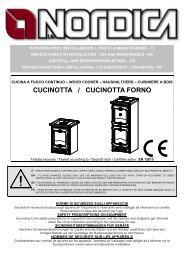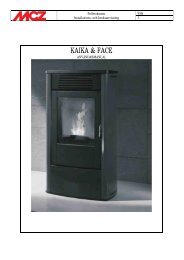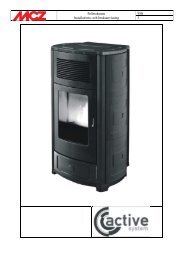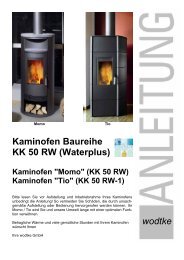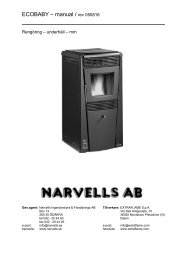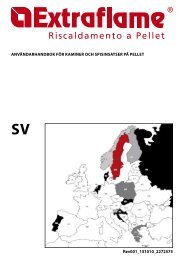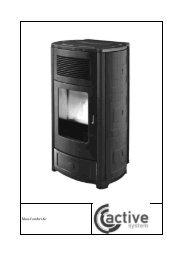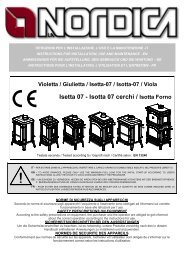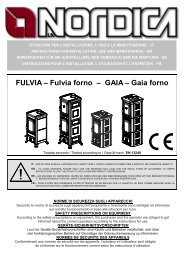TERMOROSA TR-02 - Narvells
TERMOROSA TR-02 - Narvells
TERMOROSA TR-02 - Narvells
You also want an ePaper? Increase the reach of your titles
YUMPU automatically turns print PDFs into web optimized ePapers that Google loves.
5. FLUE<br />
Essential requirements or correct operation of the appliance:<br />
• the internal section must be circular;<br />
• it must be insulated thermally and impermeable<br />
and built with materials resistant to heat, products<br />
of combustion and any condenses;<br />
• be free of obstructions and have vertical<br />
passageway with deviations not greater than 45°;<br />
• if already used must be clean;<br />
• comply with technical data of the instruction<br />
manuals;<br />
If the flues were square or rectangular the internal<br />
corners must be rounded with a radius not less than 20<br />
mm. For the rectangular section the maximum ratio<br />
between the sides must be = 1.5.<br />
A section that is too small causes a fall in the draught. A<br />
minimum height of 4m is recommended.<br />
The following are forbidden and compromise the good<br />
operation of the appliance: fibrocement, galvanised steel,<br />
internal rough and porous surfaces. Picture 4 shows<br />
some sample solutions.<br />
The minimum section must be of 4 dm 2 (for example<br />
20x20cm) for appliances whose conduit diameter is<br />
lower than 200mm, or 6.25dm 2 (for example 25x25cm)<br />
for appliances with a diameter greater than 200mm.<br />
Wood burning stove/cooker – <strong>TERMOROSA</strong> <strong>TR</strong><strong>02</strong><br />
The draught created by your flue must be sufficient but not excessive.<br />
A section of the flue that is too large can present a volume too large to heat and therefore cause difficulty in<br />
operation of the appliance; to avoid this maintain the same section for its entire height. A section that is too<br />
small causes a fall in the draught.<br />
The flue must be suitably distanced from inflammable or combustible materials by an appropriate<br />
insulation or air gap.<br />
It is forbidden to obstruct inside the tubing of systems or air ducts. It is also forbidden to install adjustable or<br />
fixed openings, on the same, to connect other devices.<br />
5.1. POSITION OF CHIMNEY CAP<br />
The draught of the flue also depends on the suitability of the chimney cap.<br />
It is therefore essential that, if built by hand, the free air outlet is more than twice the internal section of the<br />
flue.<br />
Having to always exceed the roof ridge, the chimney cap must ensure the outflow even in presence of wind<br />
(Picture 5).<br />
The chimney cap must respect the following requirements:<br />
• have an internal section equivalent to that of the chimney.<br />
• have a section of free exit double the internal one of the flue.<br />
• be built in a way so as to avoid penetration of rain, snow and any other foreign body into the flue.<br />
• be easy to inspect, for any maintenance and cleaning.<br />
(1) (2)<br />
((1) Stainless steel AISI 316 with double chamber<br />
insulated with material resistant to 400°C.<br />
Efficiency 100% excellent.<br />
(2) Refractory lined flue with double chamber and<br />
lightweight concrete cladding. Efficiency<br />
100% excellent.<br />
(3) Traditional flue in clay square section with<br />
gaps. Efficiency 80% excellent.<br />
(4) Avoid rectangular flue with aspect ratio<br />
which differs from the drawing.<br />
Efficiency 40% average.<br />
Picture 4<br />
26 Installation, user and maintenance instructions – EN – Rev.07<br />
(3)<br />
(4)<br />
A+1/2A<br />
Max.<br />
A+1/2A<br />
A




